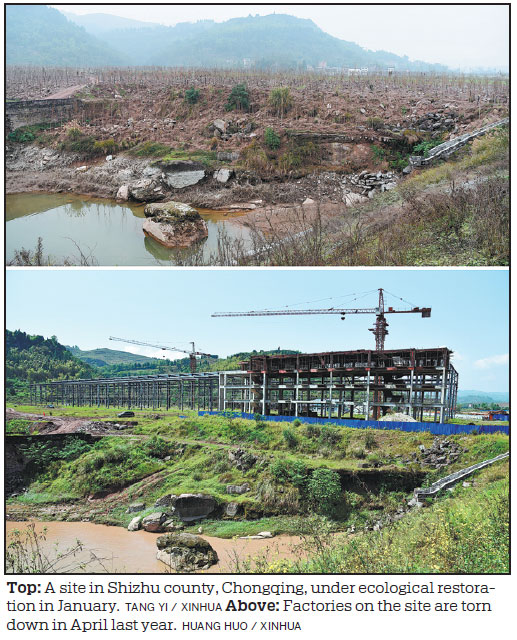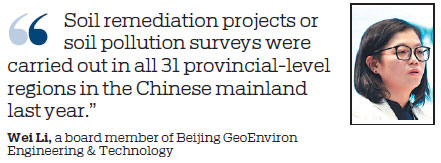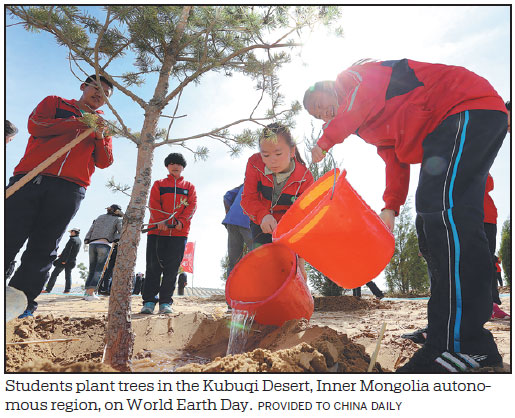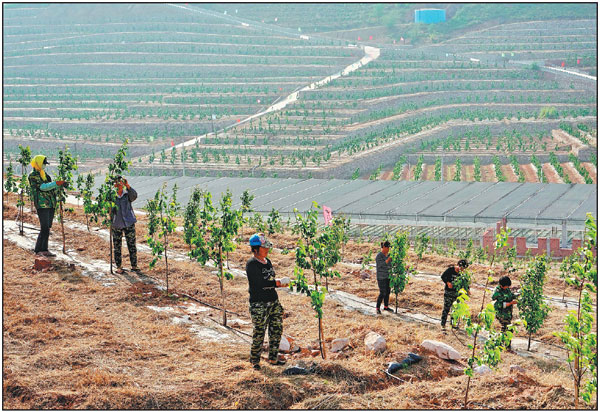Curing soil pollution set to pay dividends
Model combining ecological restoration and development promises win-win solution. Hou Liqiang reports.
The government's ambitious plans to promote ecological progress, a priority of the central leadership, have created a potential multitrillion-yuan market for soil remediation work in the next three decades.
Many companies involved in the industry have already experienced robust growth, but the potential of the market has yet to be fully unlocked.
While a lack of talent with adequate expertise is one hindrance, industry insiders say businesses involved in soil remediation also face financial challenges because returns are not immediate.
|
Workers tend to pear trees on a terrace at an eco-industrial park in Luanxian, Hebei province. Yang Shiyao / Xinhua |




They say the establishment of a business model combining ecological restoration with development projects is the key to tapping the industry's massive potential, because it could not only increase companies' incomes, enabling even bigger investment in treating polluted soil, but also help free cash-strapped local governments from the need to raise funds for expensive remediation work.
Since Xi Jinping was elected general secretary of the Communist Party of China Central Committee in November 2012 and China's president in March 2013, he has given ecological protection unprecedented emphasis.
Elion Resources, a private company headquartered in Beijing, was one of the first enterprises to spot business opportunities in the central leadership's increasing attention to the environment. Company vice-president Zhao Jinling said it decided to enter the ecological remediation industry in early 2014, with soil remediation and desertification control among its major businesses.
The rapid growth of its ecological remediation branch shows Elion made the right choice.
"The branch has achieved annual revenue growth of about 100 percent on average," Zhao said.
It started with only 20 employees, but had almost 100 by the end of 2014, with annual turnover of 400 million yuan ($59.8 million). It now has more than 1,000 employees, Zhao said, and revenue last year shot up to 5 billion yuan.
"Obviously, the high attention from the central leadership does provide an impetus for the market's development," he said.
Gaiya Env, headquartered in Suzhou, Jiangsu province, has experienced even more explosive growth since it was established in 2012, with the soil remediation solution provider's revenue rising by about two-thousandfold, according to Cheng Gongbi, the company's founder and president.
The company earned 60,000 yuan in 2012 and 120 million yuan last year.
Cheng, who has a PhD in geology, said the huge potential of China's environmental protection market was one of the factors that prompted him to quit his job at an environmental company in the United States in 2011 and return to China to found Gaiya.
Huge potential
According to a report published by the Research Institute for Environmental Industry, which is affiliated with the Beijing-headquartered China Environment News newspaper, if soil pollution is curbed by next year and the soil environment is comprehensively improved by the middle of this century, conservative estimates put the size of the market at 1.9 trillion yuan. It put the upper end of the potential market at 5.6 trillion yuan.
Wei Li, a board member of listed company Beijing GeoEnviron Engineering& Technology, forecasts that the soil remediation market in China could be worth 21.2 billion yuan this year.
One thing driving the industry's growth is an increasingly complete system of policies, laws, regulations and standards for soil remediation, she said.
The country's first national law on soil pollution and control came into effect on Jan 1. It stipulates that national and provincial funds should be established for soil remediation, and also clarifies responsibilities for soil pollution.
In addition to a general guideline for soil management, China now boasts specific regulations for this in urban areas, farms and mines. A national standard for soil quality also came into force last year, said Wei, who has been involved in the emerging industry for 15 years.
She said the country's rapid urbanization, and associated real estate development, has been another driver of the industry's growth. With the complete system in place, local governments need to remedy soil pollution before allowing land to be used for property projects.
"Soil remediation projects or soil pollution surveys were carried out in all 31 provincial-level regions in the Chinese mainland last year. Tianjin and the provinces of Jiangsu, Hunan and Zhejiang led the way, each spending more than 1 billion yuan," Wei said.
Gao Jie, secretary-general of Zhongguancun Zhongxin Soil Remediation Industry Technology Innovation Alliance, said the soil remediation industry is also booming because of industrial restructuring in many cities, with many factories being moved out of downtown areas.
The land formerly used by factories cannot be left idle, because many local governments need to develop valuable downtown land to boost their revenue. But remediation has to precede development, Gao said, because much of the land has been contaminated by industrial pollution.
"The huge market potential in soil remediation has yet to be unlocked," Gao said, adding that many projects are pilot ones because the national survey of the soil pollution situation is continuing.
He said financing is a key challenge that has been hindering the industry's development, as local governments previously had to foot the bill for soil remediation work. The law on soil pollution control may help, because it states that polluters or those with the right to use the land should pay for the cleanup.
"But it's not yet known if the polluting companies or owners of landuse rights, many of them small and medium-sized, can afford the high cost involved," Gao said. "It's also not easy to identify the polluters because it's difficult to trace how land was polluted."
The industry needs to reform the current business model, which only concentrates on soil remediation, to address the challenges, he said, adding that combining soil remediation with further development, for example real estate projects, could offer a solution.
Gao said local governments could give contracts for projects involving remediation and development to big State-owned enterprises, which have better access to financing, and companies specializing in soil remediation could become subcontractors.
Environmental improvement often makes land more valuable, and such a model could help create a win-win situation. Local governments would earn revenue from land transactions without having to pay for soil remediation, while developers could also benefit from higher land values.
Zhao agreed that the model offered a solution to the industry's financing challenges, adding that Elion had tried it successfully in a project in Tianjin.
Meanwhile, he said, the industry is also troubled by a lack of expertise in areas such as soil remediation and promoting the business model.
Cheng said Chinese universities have not provided the talent the industry needs, with students majoring in environmental engineering and science learning more about air and water pollution than soil pollution. They might know a lot about chemistry and biology, but their knowledge of geology was poor.
"My companies have to train most of the talent we need," he said. "We need to reform universities' cultivation of talent for soil remediation. It's not possible for companies to cultivate the talent they need all the time, and that makes it extremely challenging."
Contact the writer at houliqiang@chinadaily.com.cn
Emphasis on the environment: a timeline
2004: Toxic gas left at a former insecticide factory established in the 1970s poisons three workers on March 28 during construction of the Songjiazhuang subway station in Beijing's Fengtai district.
The incident prompts the authorities to pay extra attention to land affected by industrial pollution.
On June 1, China's top environmental watchdog publishes the country's first government document on polluted land, aiming to enhance control of pollution at abandoned factories.
2005: From April 2005 to December 2013, the top environmental watchdog and the Ministry of Land and Resources carry out the first nationwide soil pollution survey.
2006: A series of draft guidelines are unveiled for land pollution surveys, risk assessments and remediation, and testing technologies.
2007: The State Council, China's Cabinet, publishes the 11th Five-year Plan (2006-10), which calls for the establishment of a system for soil quality assessment and monitoring and the launch of pilot soil remediation projects.
2008: The top environmental watchdog publishes a guideline on strengthened soil pollution control, which includes principles, targets, key areas and detailed measures.
2011: The State Council approves the 12th Five-year Plan (2011-15) for heavy metal pollution control, which lists 14 key provincial-level regions, 138 regions and 4,452 enterprises as targets for control.
The plan vows to reduce emissions of major heavy metals, including lead, mercury and chromium, in 2015 by 15 percent from levels in 2007.
2012: A plan for controlling heavy metal pollution in Hunan province's Xiangjiang River is launched.
It includes 927 projects with a total investment of 59.5 billion yuan ($8.86 billion).
2013: The State Council publishes a document calling for the country's soil pollution situation to be figured out by 2015, with steps toward curbing increasing soil pollution.
2015: The top environmental watchdog launches soil pollution control and remediation projects in 10 provincial-level regions.
2016: The State Council releases an Action Plan for Soil Pollution Prevention and Control that pledges to curb worsening soil pollution by 2020, place soil pollution risks under control by 2030, and form a virtuous cycle in the ecosystem by 2050.
2017: Five central government departments, including the ministries of environmental protection, and land and resources, hold a joint conference on the implementation of the Action Plan for Soil Pollution Prevention and Control. They commit to figuring out the pollution situation for agricultural land and land used by key industries.
2018: President Xi Jinping, presiding over a national ecology and environmental conference from May 18 to 19, asks for comprehensive implementation of the Action Plan for Soil Pollution Prevention and Control.
He also calls for soil pollution control and remediation efforts to be strengthened.
(China Daily 03/20/2019 page5)



















